Related Research Articles

The Gulf Coast of the United States is the coastline along the Southern United States where they meet the Gulf of Mexico. The coastal states that have a shoreline on the Gulf of Mexico are Texas, Louisiana, Mississippi, Alabama, and Florida, and these are known as the Gulf States.
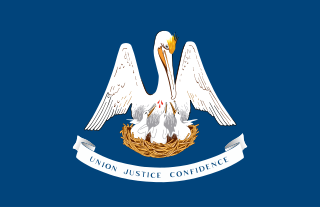
Louisiana is a state in the Deep South region of the South Central United States. It is the 19th-smallest by area and the 25th most populous of the 50 U.S. states. Louisiana is bordered by the state of Texas to the west, Arkansas to the north, Mississippi to the east, and the Gulf of Mexico to the south. A large part of its eastern boundary is demarcated by the Mississippi River. Louisiana is the only U.S. state with political subdivisions termed parishes, which are equivalent to counties. The state's capital is Baton Rouge, and its largest city is New Orleans.

Pinckney's Treaty, also commonly known as the Treaty of San Lorenzo or the Treaty of Madrid, was signed in San Lorenzo de El Escorial on October 27, 1795 and established intentions of friendship between the United States and Spain. It also defined the border between the United States and Spanish Florida, and guaranteed the United States navigation rights on the Mississippi River. With this agreement, the first phase of the ongoing border dispute between the two nations in this region, commonly called the West Florida Controversy, came to a close.

A po' boy is a traditional sandwich from Louisiana. It almost always consists of meat, which is usually roast beef or fried seafood, often shrimp, crawfish, fish, oysters or crab. The meat is served on New Orleans French bread, known for its crisp crust and fluffy center.
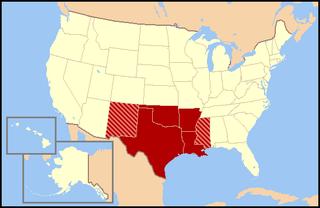
The South Central United States or South Central states is a region in the south central portion of the Southern United States. It evolved out of the Old Southwest, which originally was literally the western U.S. South, as can be seen in the now defunct Southwest Conference of the National Collegiate Athletic Association (NCAA). The states of Arkansas, Louisiana, Oklahoma, and Texas are almost always considered the "core" of the region. As part of the East South Central States sub-group of the Census Bureau classification, Alabama, Mississippi, Tennessee and Kentucky are also frequently listed under the heading. At the highest extent, Kansas, and Missouri, may be included by some sources. All or parts these states are in the Central Time Zone. At different times, all of the above states were/are considered part of the Western United States in American history.

Perdido River, historically Rio Perdido (1763), is a 65.4-mile-long (105.3 km) river in the U.S. states of Alabama and Florida; the Perdido, a designated Outstanding Florida Waters river, forms part of the boundary between the two states along nearly its entire length and drains into the Gulf of Mexico. During the early 19th century it played a central role in a series of rotating boundary changes and disputes among France, Spain, Great Britain, and the United States.

The Roman Catholic Archdiocese of New Orleans,, is an ecclesiastical division of the Roman Catholic Church administered from New Orleans, Louisiana. It is the second-oldest diocese in the present-day United States, having been elevated to the rank of diocese on April 25, 1793, by Pope Pius VI during Spanish colonial rule. Our Lady of Prompt Succor and St. Louis, King of France are the patron saints of the archdiocese and Cathedral Basilica of Saint Louis is its mother church as St. Patrick's Church serves as the Pro-Cathedral of the archdiocese.

The Times-Picayune | The New Orleans Advocate is an American newspaper published in New Orleans, Louisiana, since January 25, 1837. The current publication is the result of the 2019 acquisition of The Times-Picayune by the New Orleans edition of The Advocate, which began publication in 2013 as a response to The Times-Picayune switching from a daily publication schedule to a Wednesday/Friday/Sunday schedule in October 2012.
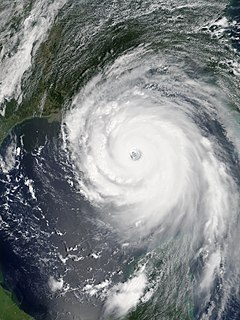
Hurricane Katrina was a Category 5 tropical cyclone that occurred in August 2005, which caused $125 billion in damage, particularly in the city of New Orleans and the surrounding areas, and over 1,200 deaths. It is the costliest tropical cyclone on record, tying with Hurricane Harvey in 2017. The storm was the third major hurricane of the 2005 Atlantic hurricane season, and the fourth-most intense Atlantic hurricane on record to make landfall in the contiguous United States, behind the 1935 Labor Day hurricane, Hurricane Camille in 1969, and Hurricane Michael in 2018.
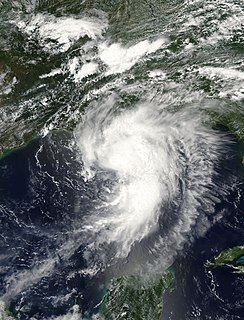
Hurricane Cindy was a tropical cyclone that briefly reached minimal hurricane strength in the Gulf of Mexico during July in the 2005 Atlantic hurricane season and made landfall in Louisiana. It was the third named storm and first hurricane of the season. Cindy was originally thought to have been a tropical storm at peak strength, but was upgraded to a Category 1 hurricane in the post-storm analysis. Cindy formed on July 3 just east of the Yucatán Peninsula in the Caribbean Sea. The depression soon made landfall on the peninsula and weakened before reemerging in the Gulf of Mexico on July 4. The storm strengthened as it moved north becoming a hurricane just before making landfall near Grand Isle, Louisiana, on July 5. The storm weakened as it moved overland and became extratropical on July 7.

Hurricane Juan was a large and erratic tropical cyclone that looped twice near the Louisiana coast, causing widespread flooding. It was the tenth named storm of the 1985 Atlantic hurricane season, forming in the central Gulf of Mexico in late October. Juan moved northward after its formation, and was subtropical in nature with its large size. On October 27, the storm became a hurricane, reaching maximum sustained winds of 85 mph (140 km/h). Due to the influence of an upper-level low, Juan looped just off southern Louisiana before making landfall near Morgan City on October 29. Weakening to tropical storm status over land, Juan turned back to the southeast over open waters, crossing the Mississippi River Delta. After turning to the northeast, the storm made its final landfall just west of Pensacola, Florida, late on October 31. Juan continued quickly to the north and was absorbed by an approaching cold front, although its moisture contributed to a deadly flood event in the Mid-Atlantic states.
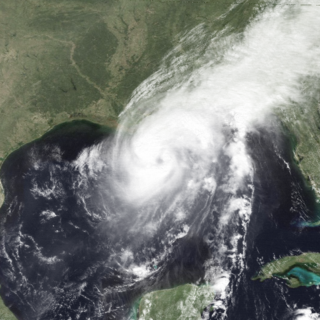
Hurricane Florence was the third of four named tropical cyclones to make landfall on the United States during the 1988 Atlantic hurricane season. The seventh tropical storm and second hurricane of the season, Florence developed on September 7 from an area of convection associated with a dissipating frontal trough in the southern Gulf of Mexico. After initially moving eastward, the storm turned northward and strengthened. Florence reached hurricane status and later peak winds of 80 mph (130 km/h) on September 9 shortly before striking southeastern Louisiana. The storm rapidly weakened over land and dissipated on September 11 over northeastern Texas.
The Gulf Coast Limited was a passenger train operated by Amtrak in the southern United States. It ran daily from Mobile, Alabama, to New Orleans Union Passenger Terminal in New Orleans, Louisiana.
This article covers the effect of the Deepwater Horizon disaster and the resulting oil spill on global and national economies and the energy industry.
The Gulf Coast Ecosystem Restoration Task Force is the organization created by President Barack Obama to recover from the 2010 BP Deepwater Horizon oil spill and preserve the ecosystem of the Gulf Coast of the United States.
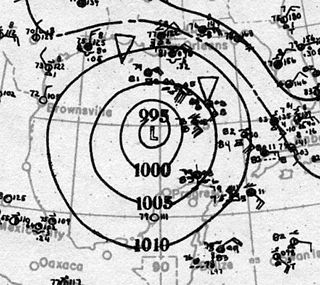
The 1920 Louisiana hurricane was a strong tropical cyclone that caused significant damage in parts of Louisiana in September 1920. The second tropical storm and hurricane of the annual hurricane season, it formed from an area of disturbed weather on September 16, 1920, northwest of Colombia. The system remained a weak tropical depression as it made landfall on Nicaragua, but later intensified to tropical storm strength as it moved across the Gulf of Honduras, prior to making a second landfall on the Yucatán Peninsula. Once in the Gulf of Mexico, the storm quickly intensified as it moved towards the north-northwest, reaching its peak intensity as a Category 2 hurricane with winds of 100 mph (160 km/h) prior to making landfall near Houma, Louisiana with no change in intensity. Afterwards, it quickly weakened over land, before dissipating on September 23 over eastern Kansas.
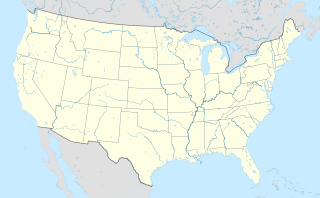
The cuisine of New Orleans encompasses common dishes and foods in New Orleans, Louisiana. It is perhaps the most distinctively recognized regional cuisine in the United States. Some of the dishes originated in New Orleans, while others are common and popular in the city and surrounding areas, such as the Mississippi River Delta and southern Louisiana. The cuisine of New Orleans is heavily influenced by Creole cuisine, Cajun cuisine, and soul food. Seafood also plays a prominent part in the cuisine. Dishes invented in New Orleans include po' boy and muffuletta sandwiches, oysters Rockefeller and oysters Bienville, pompano en papillote, and bananas Foster, among others.
John Currence is an American chef based in Oxford, Mississippi. As of 2019 he owns four restaurants in the city of Oxford: City Grocery, Big Bad Breakfast, Bourè, and Snackbar in addition to a catering business, The Main Event. Currence also owns numerous Big Bad Breakfast locations in Alabama, Florida, Tennessee and South Carolina. He won a James Beard Award in 2009 for the category of Best Chef, South, at City Grocery. He later also participated in the third season of the Bravo television competition Top Chef Masters.

The Chandeleur Sound is a sound that lies between mainland Louisiana and the Chandeleur Islands in Saint Bernard Parish. It is situated east of Breton Sound and south of Mississippi Sound. It was formed by the mixing of the Gulf of Mexico and the waters of the Mississippi River, protected by the Islands.
References
- New Orleans Times Picayune article on 2009 Great American Seafood Cook-Off with interview of Gulfscapes Magazine publisher
- New Orleans Times Picayune website, NOLA.com article on 2008 Great American Seafood Cook-Off listing Gulfscapes Magazine as sponsor
- Louisiana Seafood Promotion and Marketing Board Website Listing Founder Bio
- UPC Database
- Trademark